*This post may contain affiliate links. Read more »
This classic pilau rice, Nasi Minyak (translated to “oiled rice”), is the pinnacle of Malay cuisine. If you thought my Nasi Uduk Betawi or nasi kunyit were flavorful (I mean, you are right about that, but) this is like that on flavor level 11.
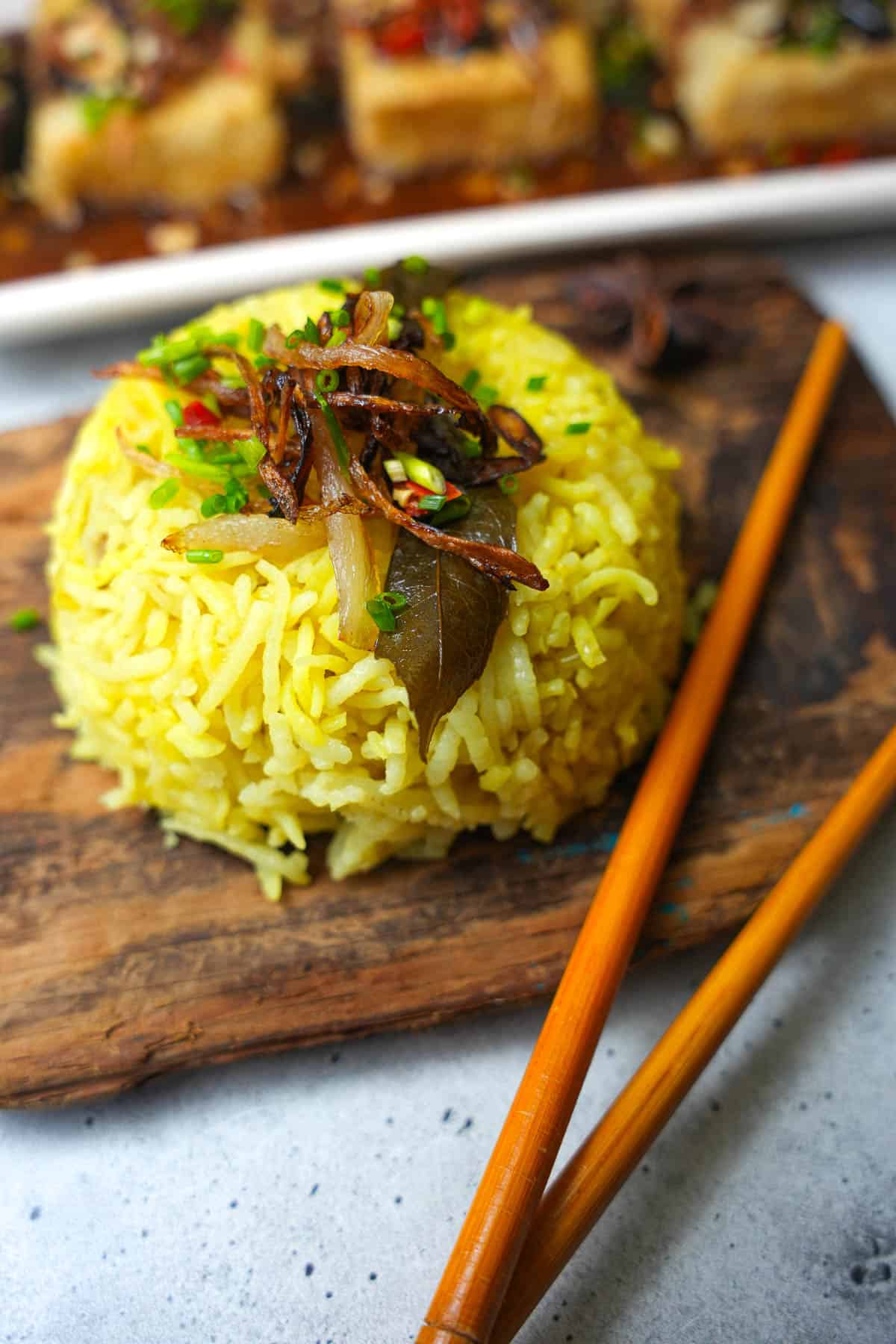

Enter your email & I'll send it to your inbox. Plus, get great new recipes from me every week!
By submitting this form, you consent to receive emails from Cinnamon Snail.
With clear, step-by-step instructions, carefully designed to accommodate varying ingredients worldwide, you’ll breeze through each step effortlessly, avoiding common pitfalls. This particular recipe is your map to a successful first attempt, just straightforward guidance to aromatic rice triumph.
Nasi minyak is of course, the perfect fragrant bed to serve Sambal Goreng Tempeh, and Tahu Goreng, but it can also make amazing rice to serve vegan butter chicken, or your favorite dal tadka over.
Let’s get you started mastering Nasi Minyak and infusing your home with the authentic aroma of Malaysia!
Jump to:
🥰Why you'll adore this Malaysian rice recipe
✊ Vegan AF: No animals are harmed in this scrumptious pilau. Let’s rewind the tape of cultural history because the dish means oiled rice, not ghee rice! Like all of my vegan Malaysian recipes, this Nasi Minyak has all of the flavor, with none of the animal products, or cholesterol that comes from ghee, or canned evaporated milk that people sometimes use in it.
🏃♂️A Fast Rice Prep Packed with Malay Flavors: Like my vegan biryani recipe, this gets made with quick-cooking aged basmati rice, and comes together quickly in one pot while you prepare the rest of your meal.
✅ Tested and Approved Worldwide: Like all of my vegan recipes, this one’s been perfected through meticulous tweaks and vetted by recipe testers around the world, including in Malaysia and Indonesia where the dish is from.


Warning: This Will Transform Your Vegan Indo Cooking!
This 6-day plant-based deep dive into the vibrant cuisine of Indonesia is 100% FREE.
🌿 What's in this malaysian rice recipe?
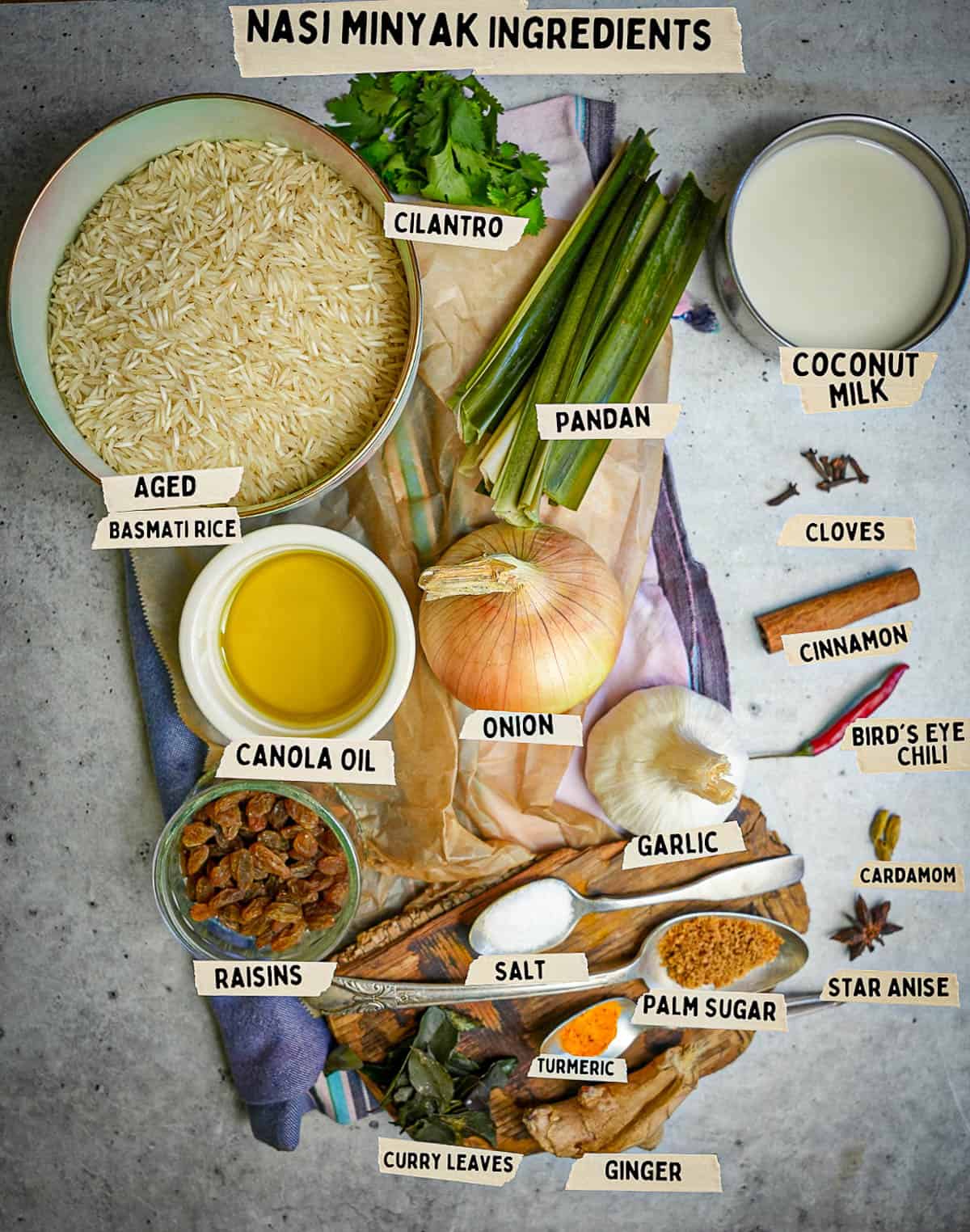
Curry Leaves
Curry leaves infuse our Nasi Minyak with an aromatic depth that’s distinctive and delightful. Nutrient-rich and brimming with antioxidants, these leaves lend a burst of flavor reminiscent of citrus and warm spices. In our recipe, they dance alongside other spices, enhancing the overall symphony of taste. If you’ cannot find fresh curry leaves, consider using dried or frozen curry leaves as a substitute, or just leave them out altogether.
Pandan
A staple in Malaysian and Southeast Asian cooking (especially in sweets like kuih dadar, klepon and taro pudding), pandan leaves contribute a delicate, sweet, floral aroma that’s harmonious with the dish’s character. Most Asian food stores sell pandan, either refrigerated or frozen. I prefer using fresh leaves to extracts which often contain artificial ingredients.
Indonesian Bay Leaf
The Indonesian bay leaf, or daun salam, imparts a subtle, and earthy essence. These leaves offer a backdrop of flavor that complements the dish’s complexity. If you can’t find Indonesian bay leaves, the Mediterranean variety can serve as a substitute.
Star Anise
Star anise is a striking spice that plays a leading role in Nasi Minyak’s aromatic allure. Should you be without star anise, a pinch of ground anise seeds, or even a few drops of anise extract can step in as substitutes.
Aged Basmati Rice
A crown jewel of Indian rice varieties, aged basmati rice embodies the essence of sophistication. Its hyper-long grains, aromatic fragrance, and distinct texture provide a canvas for Nasi Minyak’s flavors to shine. In the absence of aged basmati rice, regular basmati rice, or jasmine rice can be used without modifying the recipe. If you would like to use brown rice, red rice, or a different variety altogether, you may need to adjust the amount of water, and the cooking time a little.
Cooking Oil
Almost any neutral-flavored cooking oil will work great in this recipe. I recommend canola, sunflower, vegetable, or peanut oil. Rice cooked in clarified butter is often how people think of this dish, but with all of the rich and flavorful ingredients in my recipe, I promise you will not miss the ghee!
*See the recipe card at the bottom of the page for exact quantities, nutritional info, and detailed cooking directions.
📖 How to make this nasi minyak recipe
Make this perfectly on your first shot by following these step-by-step instructions with important tips. Or you can follow along with the easy-to-print recipe card towards the bottom of this page.

Step One
Begin by thoroughly rinsing the aged basmati rice under cold water until the water runs clear. Then, allow the rice to soak in water for around 30 minutes. Once soaked, drain the rice effectively.
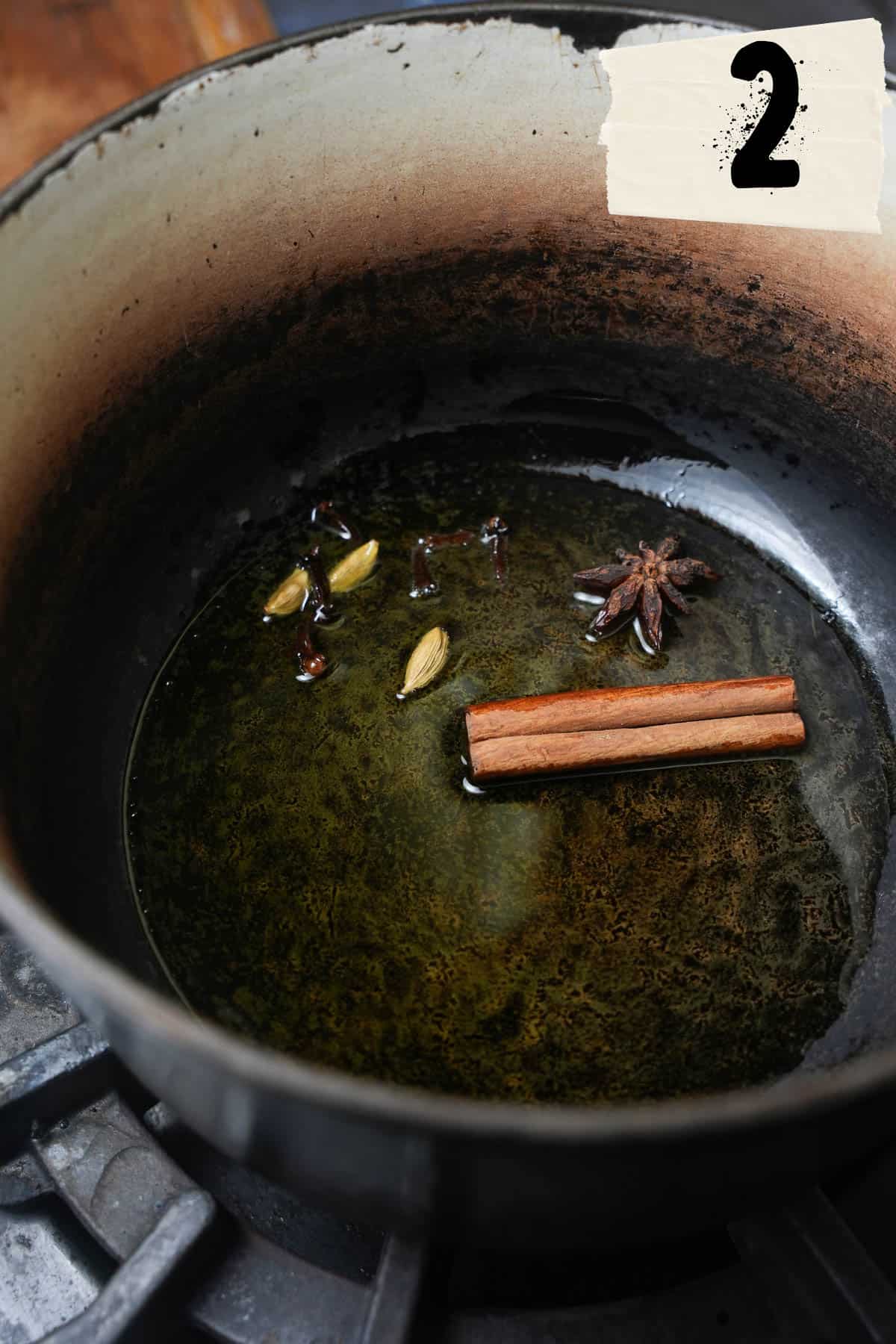
Step Two
In a medium-sized pot, heat cooking oil over medium heat. After 90 seconds, when the oil is hot, add the cinnamon stick, cardamom pods, cloves, and star anise, and let them sizzle and release their fragrant aromas through a brief stir-fry of approximately 1-2 minutes.
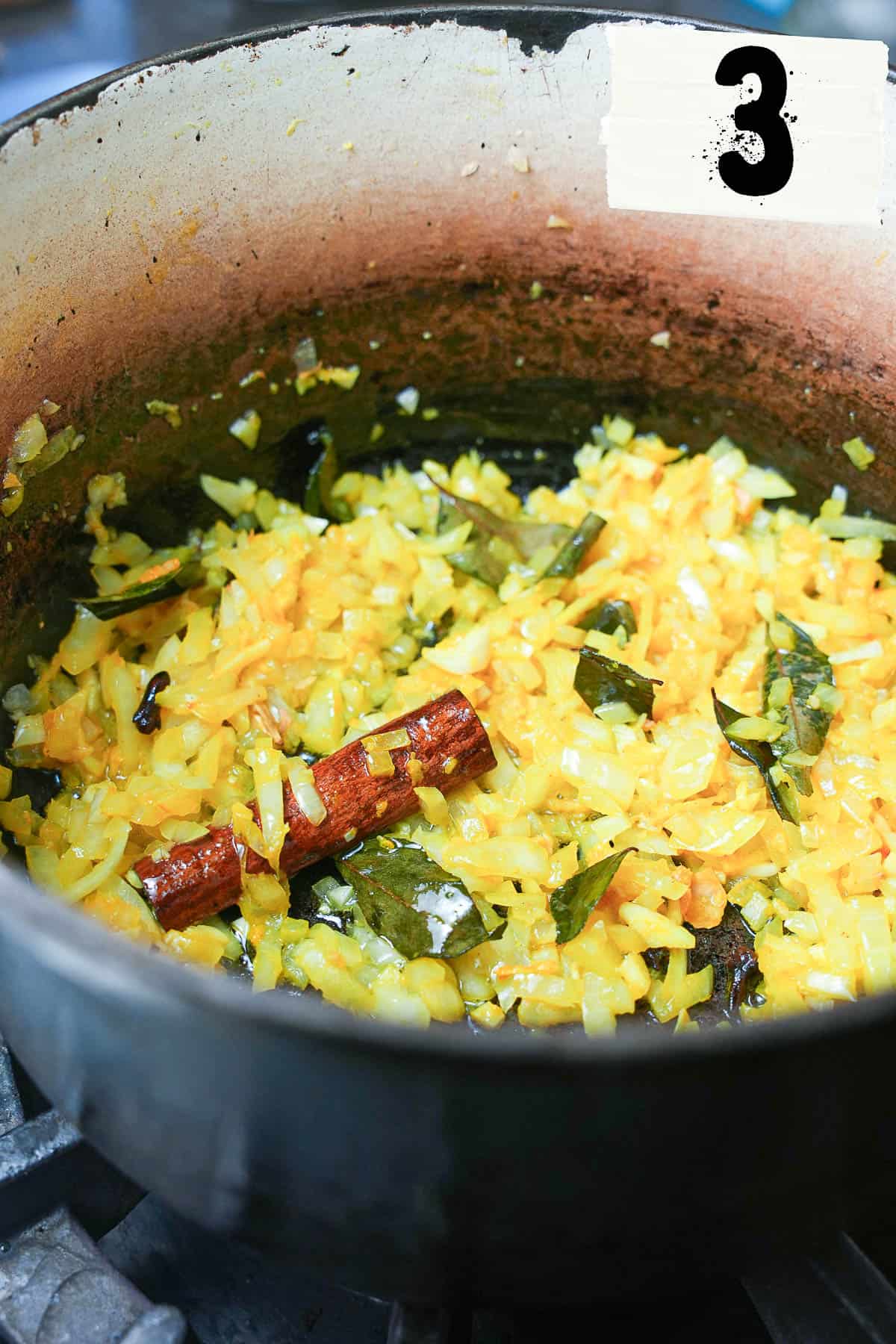
Step Three
Stir in the turmeric powder, minced onion, garlic, and curry leaves. Sauté stirring, for three minutes until the onion becomes translucent yellow.

Step Four
Add the freshly grated ginger, pandan leaves, raisins, and drained basmati rice, ensuring each grain is coated in the aromatic symphony of spices and ingredients.
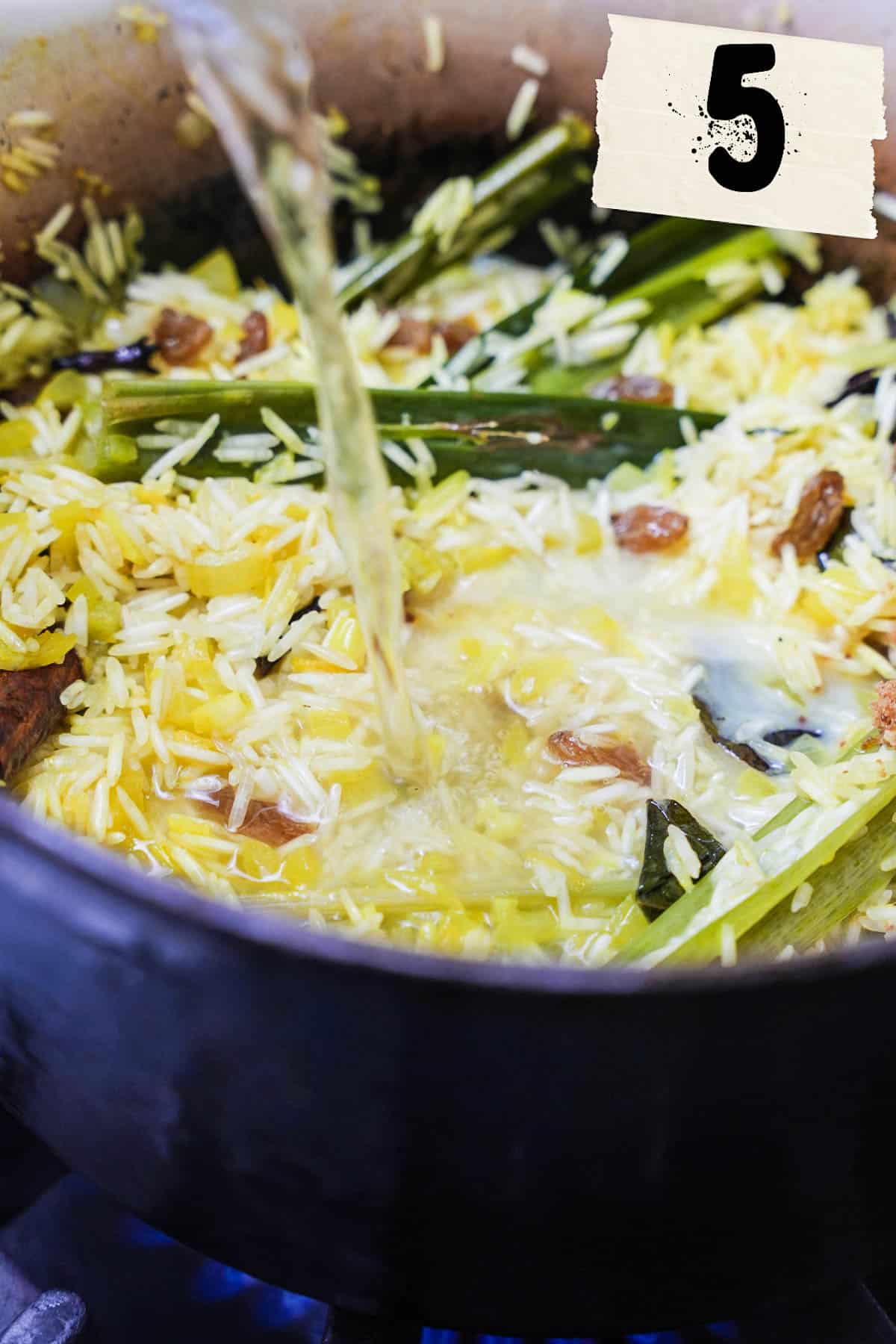
Step Five
Sprinkle in the palm sugar and a pinch of salt. Pour in the water and coconut milk, giving everything a thorough stir. Increase the heat to high and bring the mixture to a gentle boil.

Step Six
Once boiling, reduce the heat to low, cover the pot snugly with a lid, and allow the rice to simmer gracefully for approximately 20-25 minutes, until the rice is tender and the liquid has been absorbed.

Step Seven
Gently fluff the nasi minyak with a fork, separating the grains. If desired, remove the cinnamon stick, cardamom pods, cloves, star anise, and pandan leaves. Garnish with slices of bird’s eye chili, crispy fried shallots, minced chives and cilantro leaves.
🍽️Serving Ideas
For a hearty and robust feast, consider topping this fragrant rice with bihun goreng, sayur lodeh with banana leaf steamed lontong, or vegan butter chicken (don't freak out, it's made with my tender seitan). Need more veggies in your life? make this rice the natural bed for a giant nourishing pile of urap sayur to rest upon!
Pair your Nasi Minyak with tofu sisig, or smokey eggplant ensaladang talong from the Philippines.
For those seeking extra fire, consider enhancing the experience with pickled green chilies, nuoc mam for a Vietnamese vibe, or shatta sauce made from fermented red or green chiles.
What about a Southeast Asian dessert after this?
Delight in the delicate sweetness of banh flan, tupig, taro rice pudding, the vibrant layers of che ba mau, or the comforting warmth of martabak.

👉Top tips
- Rinse and Soak Right: Thoroughly rinse aged basmati rice till clear; soak for 30 minutes. Getting rid of extra starch, and the presence of oil in this recipe both help prevent the rice from clumping.
- Layered Flavors: Following the order of the steps in this recipe brings out the best of the spices, herbs, and aromatics.
- Rest and Reap: Let rice rest covered for 10 minutes to enhance flavors; fluff with a fork to aerate the rice, remove spices, and serve hot.
🤷♀️FAQ
🥶 Storage:
Allow the Nasi Minyak to cool to room temperature before storing. Transfer it to an airtight container, and store it in the refrigerator for up to 4 days. Don’t freeze this dish.
🔥Stovetop Reheating:
Place the desired portion of Nasi Minyak in a saucepan.
Add a splash of water to prevent sticking.
Cover the saucepan with a lid and heat over medium-low heat.
Stir occasionally to ensure even reheating.
☢️ Microwave Reheating:
Transfer a serving of Nasi Minyak to a microwave-safe bowl.
Add a small amount of water to maintain moisture.
Cover the bowl with a microwave-safe plate or lid.
Heat in the microwave at 50% power in 1-minute increments, stirring between intervals until hot throughout.
Absolutely, Nasi Minyak is inherently gluten-free, dairy-free-and egg-free.
Most Asian grocery stores sell pandan leaves either refrigerated or frozen. You can use a few drops of natural pandan extract in place of the leaves if you can’t find them.
Aged basmati rice enhances the dish’s aroma and texture, but regular basmati, or jasmine work seamlessly as substitutes. If you want to use brown or red rice, you may need to add a little extra water, and allow for slightly longer cooking time.
Absolutely! Start the process in a saucepan. Once the onions, herbs, and spices are sautéed, just add them along with the rice and remaining ingredients in a rice cooker, and cook for about 20 minutes, or following your particular machine’s settings for white rice.
💣 BOMB dishes to serve over this classic Malaysian rice:
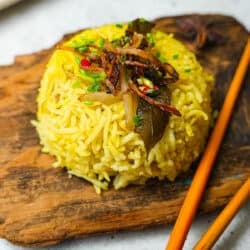
Nasi Minyak (Malaysian Pilau Rice)
Equipment
Ingredients
Rice
- 2 cups aged basmati rice 375 g.
- 3 tablespoons cooking oil canola oil, sunflower oil, or vegetable oil
- 1 cinnamon stick
- 3 whole cardamom pods
- 6 whole cloves
- 1 whole star anise
- ¼ teaspoon turmeric powder
- 1 small size onion minced
- 3 cloves garlic minced
- 10 curry leaves
- 2 teaspoons grated fresh ginger
- 2 fresh or frozen pandan leaves
- ⅓ cup raisins I prefer green Hunza raisins, but you can use any kind
- 1 ½ teaspoon palm sugar or brown sugar
- 1 ½ teaspoon salt
- 2 ¾ cups water
- 1 cup coconut milk
Garnish
- 1 bird’s eye chili sliced
- Fried shallots
- Cilantro leaves
Instructions
- Wash the aged basmati rice under cold water until the water runs clear. Soak the rice in water for about 30 minutes, then drain.
- In a large pot, heat your choice of cooking oil over medium heat. Add the cinnamon stick, cardamom pods, cloves, and star anise. Stir-fry the spices for about 1-2 minutes until fragrant.
- Sprinkle in the turmeric powder and give it a quick stir. Toss in the minced onion, garlic, and curry leaves. Cook, stirring occasionally, until the onion turns translucent.
- Add the grated fresh ginger, pandan leaves, raisins, and drained basmati rice. Stir gently to coat the rice with the aromatic spices and other ingredients.
- Sprinkle in the palm sugar and salt. Pour in the water and coconut milk. Give everything a good stir.
- Increase the heat to medium-high and bring the mixture to a boil. Once boiling, reduce the heat to low, cover the pot with a tight-fitting lid, and let it simmer for about 20-25 minutes. The rice should be just tender and the liquid absorbed.
- Once the rice is cooked, remove the pot from heat but keep it covered. Let the rice rest for an additional 10 minutes before you fluff the nasi minyak with a fork to separate the grains. Remove the cinnamon stick, cardamom pods, cloves, star anise, and pandan leaves if desired.
- Serve the nasi minyak hot, garnished with sliced bird’s eye chili, fried shallots, and cilantro leaves.
Notes
Don’t forget to fluff the rice so that the grains are nicely separated, and the seasonings are sure to be well distributed throughout the rice. You can either leave the whole seasonings (cardamom pods, pandan leaves, star anise) in the recipe, or remove them before you serve the rice. I think those things are pretty, and easy to avoid, but you know your family. If they are going to get mad that they bit into a whole cardamom pod, save them the issue by getting it out of their way!

Enter your email & I'll send it to your inbox. Plus, get great new recipes from me every week!
By submitting this form, you consent to receive emails from Cinnamon Snail.

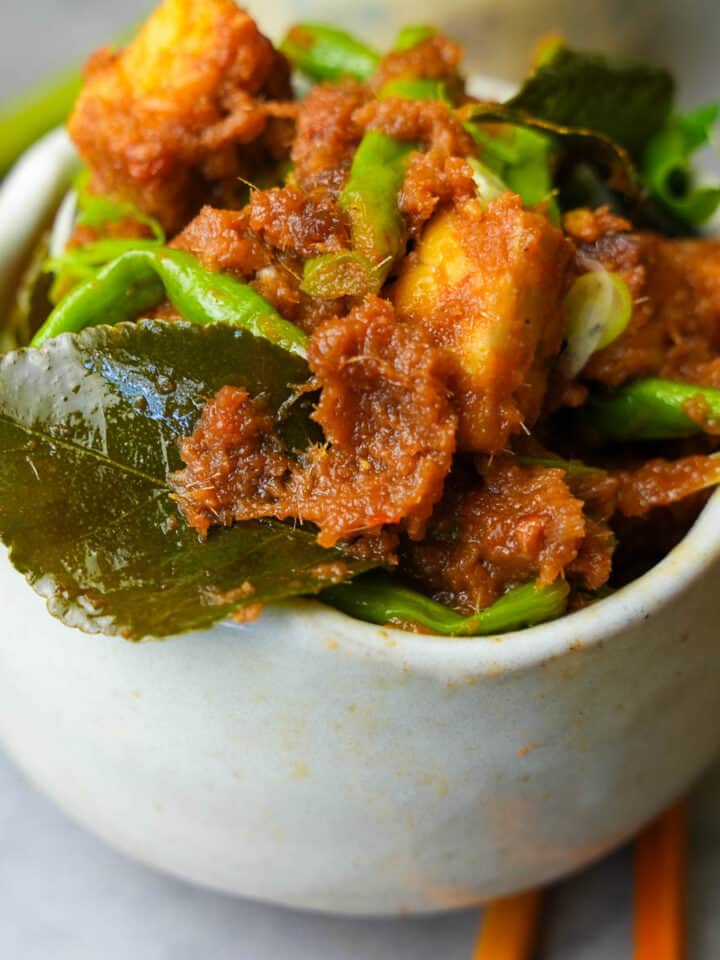
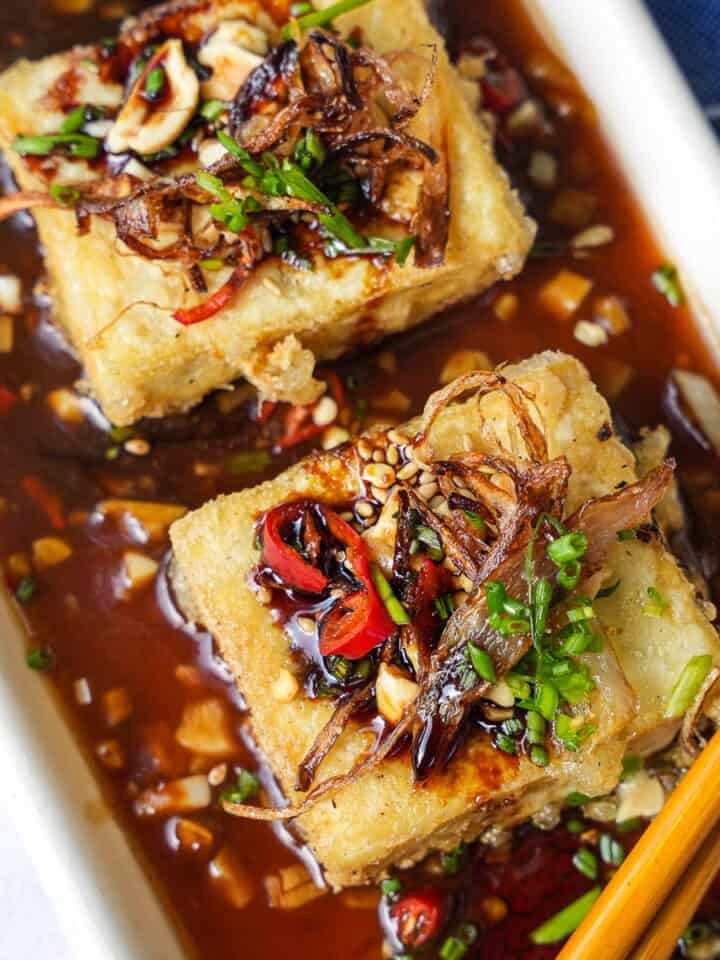
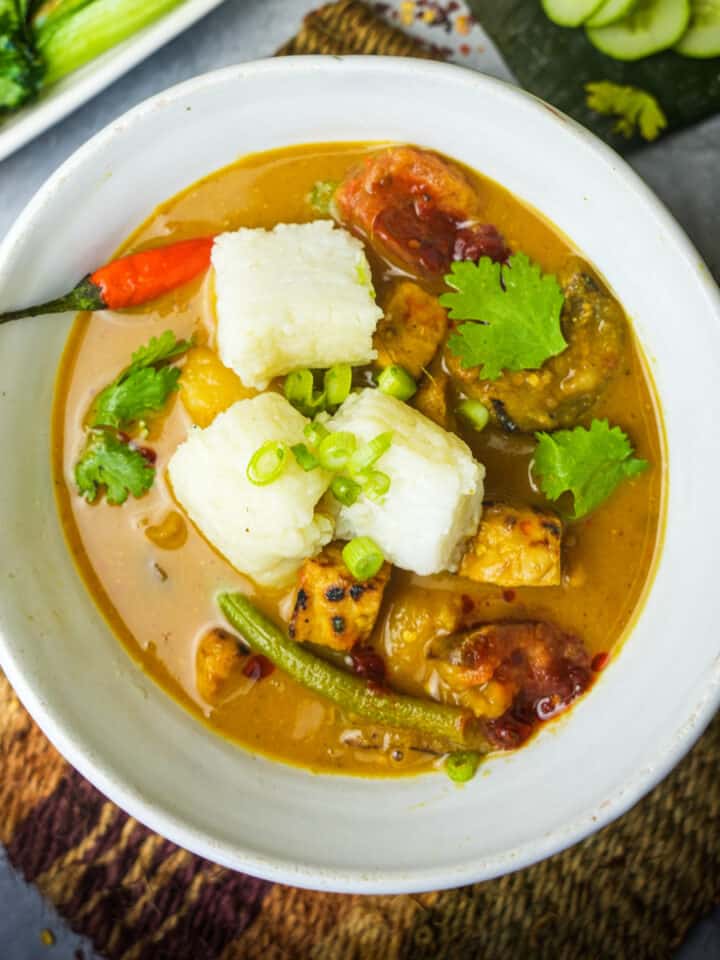
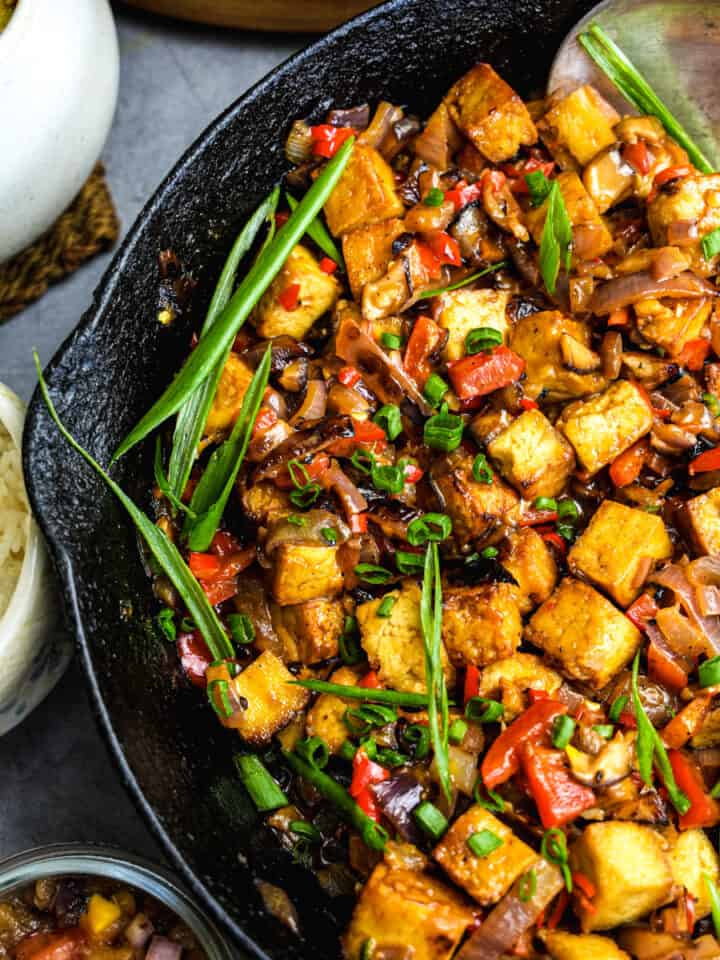





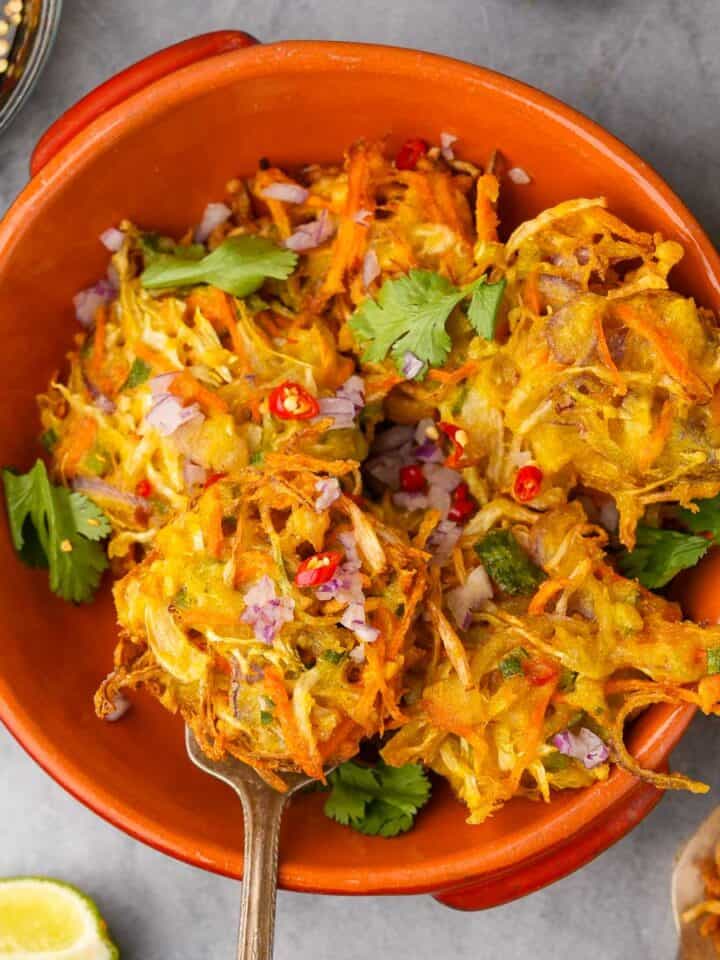
Marna says
How can you not comment on this? This is sublime...it came out so fluffy so delicious...spice perfection....dont miss out!